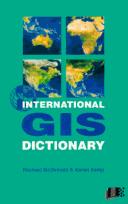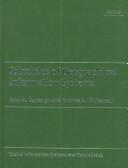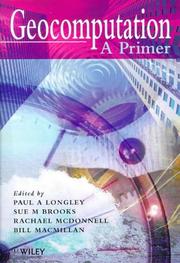| Listing 1 - 7 of 7 |
Sort by
|

ISBN: 1899761195 9781899761197 0470236078 Year: 1995 Publisher: Cambridge GeoInformation International
Abstract | Keywords | Export | Availability | Bookmark
 Loading...
Loading...Choose an application
- Reference Manager
- EndNote
- RefWorks (Direct export to RefWorks)

ISBN: 0198233655 9780198233657 0198233663 Year: 1998 Publisher: Oxford : Oxford University Press,
Abstract | Keywords | Export | Availability | Bookmark
 Loading...
Loading...Choose an application
- Reference Manager
- EndNote
- RefWorks (Direct export to RefWorks)
V
Geography --- Information systems --- Geographic information systems --- environment --- Modèle --- Models --- Information processing --- Cartographie --- cartography --- Satellite --- Satellites --- Application des ordinateurs --- computer applications --- Système d'information géographique --- Geographical information systems --- 550.81 --- 681.3*H4 --- Geological prospecting. Simplest exploration methods. Geomorphological investigations while prospecting --- Information systems applications (GIS etc.) --- 681.3*H4 Information systems applications (GIS etc.) --- 550.81 Geological prospecting. Simplest exploration methods. Geomorphological investigations while prospecting --- GIS (Information systems) --- Information storage and retrieval systems --- Geographic information systems. --- Environmental Sciences and Forestry. Remote Sensing and Geographical Information Systems --- Geographical Information Systems.

ISBN: 0471985759 0471985767 9780471985761 Year: 1998 Publisher: New York, NY : John Wiley,
Abstract | Keywords | Export | Availability | Bookmark
 Loading...
Loading...Choose an application
- Reference Manager
- EndNote
- RefWorks (Direct export to RefWorks)
This book encompasses all that is new in geocomputation. It is also a primer - that is, a book which sets out the foundations and scope of this important emergent area from the same contemporary perspective. The catalyst to the emergence of geocomputation is the new and creative application of computers to devise and depict digital representations of the Earths surface. The environment for geocomputation is provided by geographical information systems (GIS), yet geocomputation is much more than GIS. Geocomputation is a blend of research-led applications which emphasise process over form, dynamics over statics, and interaction over passive response. This book presents a timely blend of current research and practice, written by the leading figures in the field. It provides insights to a new and rapidly developing area, and identifies the key foundations to future developments. It should be read by all who seek to use geocomputational methods for solving real world problems.
Geographic information systems. --- Information storage and retrieval systems --- 681.3*H4 --- Geographical information systems --- GIS (Information systems) --- Geography. --- Information systems applications (GIS etc.) --- Geography --- Environmental Sciences and Forestry. Remote Sensing and Geographical Information Systems --- Geographical Information Systems --- Geographical Information Systems. --- 681.3*H4 Information systems applications (GIS etc.) --- Geographic information systems
Book
ISBN: 0198742843 9780198742845 Year: 2015 Publisher: Oxford: Oxford university press,
Abstract | Keywords | Export | Availability | Bookmark
 Loading...
Loading...Choose an application
- Reference Manager
- EndNote
- RefWorks (Direct export to RefWorks)
Book

Year: 2018 Publisher: Washington, D.C. : The World Bank,
Abstract | Keywords | Export | Availability | Bookmark
 Loading...
Loading...Choose an application
- Reference Manager
- EndNote
- RefWorks (Direct export to RefWorks)
Droughts in Morocco are increasing in frequency and intensity. Associated with global climate change, this trend will likely be more evident in the future. Drought damage to the agricultural sector affects both rural livelihoods and the national economy as a whole. This report examinesdrought and climate variability impacts on agricultural and livestock activities in Morocco. It relies on original research on the citrus and olive value chains, which are both priorities in the government's current agricultural strategy, known as the "Green Plan" or Plan Maroc Vert (PMV). The report also considers drought impacts on cereal production, traces the government's efforts to address drought, and suggests actions to strength these efforts. Long-term climate change is making Morocco, which already faces rural water scarcity, more vulnerable to extreme weather events. Recurrent atmospheric climate events, known as teleconnections, such as the El Nino Southern Oscillation (ENSO), may further exacerbate this situation. This study finds that ENSO had limited impacts on the 2015-2016 droughts in Morocco, but other teleconnections,specifically the North Atlantic Oscillation (NAO) and the Mediterranean Oscillation (MO), had greater impacts. Increased climate variability leads to stronger droughts, which adversely affect livestock andrainfed crops. Moreover, Morocco's average temperatures are rising and rainfall is becoming more sporadic, both affecting certain parts of the country more than others. Agriculture and agribusiness activities generate over 30 percent of employment in Morocco. The agricultural sector also produces 20 percent of GDP and 35 percent of exports. Rainfed crops, like wheat, are critical for domestic food security and livestock survival, but are also most affected by climatevariability. As such, increasing droughts represent a "contingent liability" for the Moroccan economy. This impacts Morocco's trade balance as agricultural exports fall and food and fodder imports rise to meet increased domestic demand. This report suggests further drought management actions. Currently, the government is carrying out important monitoring and crop insurance programs, but more can be done to share information and strengthen inter-governmental and interagency coordination, especially with governments at the river basin level.
Adaptation to climate change --- Agricultural sector economics --- Agriculture --- Climate change and agriculture --- Crops and crop management systems --- Drought management --- Environment --- Export competitiveness --- Natural disasters --- Risk management --- Water resources --- Weather
Book

Year: 2018 Publisher: Washington, D.C. : The World Bank,
Abstract | Keywords | Export | Availability | Bookmark
 Loading...
Loading...Choose an application
- Reference Manager
- EndNote
- RefWorks (Direct export to RefWorks)
Climate change and recurrent climate events are making water-scarce countries like Tunisia and its agricultural lands drier and more vulnerable to drought. These recurrent climate events are also known as teleconnections and include natural climatic events such as the El Nino Southern oscillation (ENSO), the North Atlantic oscillation (NAO), and the Mediterranean oscillation (MO). These climate phenomena contribute to droughts, which negatively affect key rain-fed crops, suchas wheat and barley, and livestock. As a result, farmers are becoming more vulnerable as climate change and teleconnections make temperatures rise and rainfall become more sporadic. Agriculture is important for rural communities and the overall Tunisian economy. Twenty percent of the population is employed in agriculture, which accounts for 10 percent of the country's gross domestic product (GDP) and 10 to 12 percent of total exports, on average. Wheat and other rainfedcrops are critical to food security and livestock survival and are the crops most affected by climate variability. Climate change's adverse impacts on agriculture are a contingent liability for the Tunisian economy, including for the country's GDP, trade balance, and balance of payments. As agricultural and agro-industrial outputs fall, food and fodder imports must rise to meet domestic demand. Therefore, this report suggests additional action on implementing integrated drought management (IDM) on top of what the government is already doing. Food and agriculture value chains are affected by climate events. This report includes detailed analyses of two key value chains, namely wheat and dairy. The analyses were done in representative lagging regions, including Jendouba for the dairy value chain and Siliana and Beja for the wheat value chain.Currently, wheat and dairy are the main subsectors in the lagging regions, and in the short term, strengthening these subsectors will increase jobs, incomes, and food security. This study finds that the El Nino Southern oscillation (ENSO) was a less important contributor to the 2015-16 drought in Tunisia than other teleconnections. ENSO drought impacts are more pronounced in other parts of the world than in the Middle East and North Africa (MENA) region. This report also examines wheat and dairy agriculture to determine how well they are adapting to climate change and climate variability. Current adaptation pathways to increase agricultural incomes and productivityfocus on increasing tree crops, which generally are more resilient to drought than field crops. Still, improving water management is also an essential part of this adaptation plan.
Book

Year: 2018 Publisher: Washington, D.C. : The World Bank,
Abstract | Keywords | Export | Availability | Bookmark
 Loading...
Loading...Choose an application
- Reference Manager
- EndNote
- RefWorks (Direct export to RefWorks)
This volume examines the causes and consequences of drought on Lebanon's agriculture. Lebanon is getting hotter and dryer. Projections show droughts will likely become more frequent and severe. Climate change, El Nino Southern Oscillation (ENSO), and the North Atlantic Oscillation (NAO) impact the occurrence of drought to varying degrees, with NAO being the biggest short-term driver and climate change being the biggest long-term driver. The drier conditions will have important ramifications on Lebanon's agricultural economy and the wellbeing of citizens working in agriculture. Ramifications include production declines and the loss of livelihoods, among others. Drought was not considered an important issue in the country until recently. But, that view is slowly changing as a series of droughts and other extreme weather events over the past decade demanded the nation's attention. With greater awareness of drought, public institutions slowly begin to change, moving from reactionary responses to taking the first steps towards strategic planning. Still, much more can be done. These actions include: developing a national drought action plan, establishing drought monitoring systems, improving ministerial coordination, utilizing new technologies like Hydroponics and Early Warning Systems, improving the quantity and quality of climatic data, and other actions. The individual chapters of this volume were compiled using information from five commissioned background papers. These background papers relied on mostly secondary data sources. But, some primary data was collected as well. Through key informant interviews and focus group discussions, thirty stakeholders were consulted. They represent various research institutes, the private sector, government agencies, and civil society organizations. The purpose of this volume is to build off the 2013 book, Increasing Resilience to Climate Change in the Agricultural Sector of the Middle East: The Cases of Jordan and Lebanon (Verner and others 2013). That book prioritized agricultural needs in Jordan and Lebanon, including knowledge generation and technological advancement. This volume adds to both topics.This report examines the causes and consequences of drought on Lebanon's agriculture. It finds that Lebanon is getting hotter and dryer, while droughts will likely become more frequent and more severe. We see that climate change, El Nino Southern Oscillation (ENSO), and the North Atlantic Oscillation (NAO) may impact the occurrence of drought to varying degrees, with NAO being the largest short-term driver and climate change being the largest long-term driver. The drier conditions will have important ramifications on Lebanon's agricultural economy and the wellbeing of citizens working in agriculture. Impacts from drier conditions include production declines, loss of livelihoods, and many others. Until recently, drought was not considered an important issue in the country, but that view is slowly changing because of a series of droughts and other extreme weather events that occurred over the past decade. With greater awareness of drought, public institutions have also slowly begun to change, moving from reactionary responses to taking the first steps towards strategic planning.
Adaptation to climate change --- Agriculture --- Climate change and agriculture --- Climate change and environment --- Drought management --- Environment --- Natural disasters --- Rainfall --- Risk management --- Water resources --- Weather forecasting
| Listing 1 - 7 of 7 |
Sort by
|

 Search
Search Feedback
Feedback About UniCat
About UniCat  Help
Help News
News